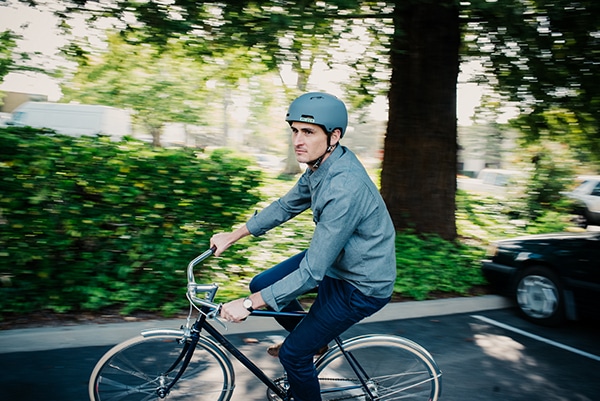Cyclists know that they’re doing their part to ease up on mother nature by opting for a self-propelled two wheels instead of a gas-guzzling four, but never before have they been able to take that environmentalism one step further by wearing a truly eco-conscious helmet. Enter the Silo. Created by bike accessory company Giro, it features a new helmet liner based around Expanded Polyactic Acid (E-PLA), a “bio-foam” derived from corn with the potential to be crafted from grasses or other plant-based materials vs. the traditional petroleum-based foam found cushioning most helmets. On top of this revolutionary material swap, the helmet can also be disassembled at the end of its lifecycle for both recycling and composting. We chatted with Chris Pietrzak, Giro’s director of advanced concepts, to learn more about the Silo Helmet—available online and in REI stores this month.
gb&d: Where did the inspiration for the Silo helmet come from?
Pietrzak: The Silo was inspired by our desire to be mindful of our impact on the planet and its resources, and to find new ways to lead the industry in head protection.
gb&d: Why do you think other helmet companies haven’t switched to making their helmet liners with E-PLA?
Pietrzak: It is a relatively new material, and with any new material there is a significant investment required to develop, test, and scale it for production. E-PLA also requires changes to the manufacturing process, which adds to the cost and complexity of the project. As a brand with a leading legacy of innovation in head protection, we thrive on the challenge and the opportunity to change the paradigm for helmets.
gb&d: I understand that, on top of the E-PLA switch, the helmet has a plastic shell and bamboo fiber webbing. How are these materials are more sustainable?
 Pietrzak: The shell is made from ABS plastic and is designed to allow disassembly from the liner for recycling, and the bamboo fiber webbing will degrade in an industrial compost.
Pietrzak: The shell is made from ABS plastic and is designed to allow disassembly from the liner for recycling, and the bamboo fiber webbing will degrade in an industrial compost.
gb&d: This is probably the only helmet on the market that you can disassemble and recycle/compost, right? Do you think this will be something we see more, both with biking products and beyond?
Pietrzak: The Silo is the first of its kind. We believe that Giro is part of a growing movement that seeks to reduce impact on our planet, and we hope that it is the start of a shift in helmet design.
gb&d: Does the Silo have the same lifespan as other helmets made with Styrofoam and other traditional materials?
Pietrzak: Yes, the Silo meets the same standards as traditional helmets with EPS foam liners, and offers the same potential lifespan. And FYI, most cycling helmets use EPS “expanded polystyrene” foam liner, which is not the same material as Styrofoam. Styrofoam is an extruded polystyrene, which has different properties than EPS.
gb&d: So is the goal, then, for Giro to phase out EPS foam altogether? What other environmental initiatives are happening at Giro?
Pietrzak: There are no immediate plans to phase out EPS, but we are looking for opportunities to use E-PLA in place of EPS and to develop other materials that can reduce impact to the environment. Three years ago, we radically changed our product packaging to maximize paper yield by minimizing cut-off waste, moved to the use of soy inks, and developed packaging that is 100% post-consumer recycled content.

